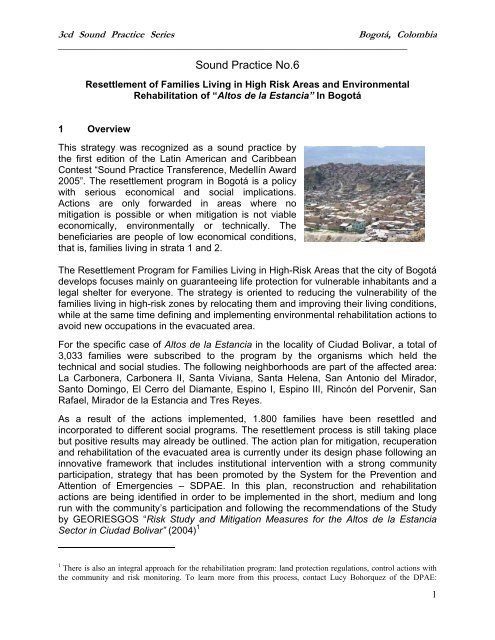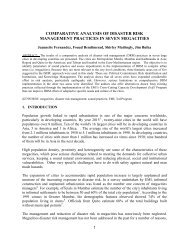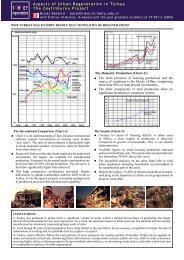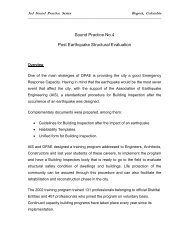Resettlement of Families Living in High Risk Areas
Resettlement of Families Living in High Risk Areas
Resettlement of Families Living in High Risk Areas
Create successful ePaper yourself
Turn your PDF publications into a flip-book with our unique Google optimized e-Paper software.
3cd Sound Practice SeriesBogotá, Colombia________________________________________________________________________Sound Practice No.6<strong>Resettlement</strong> <strong>of</strong> <strong>Families</strong> <strong>Liv<strong>in</strong>g</strong> <strong>in</strong> <strong>High</strong> <strong>Risk</strong> <strong>Areas</strong> and EnvironmentalRehabilitation <strong>of</strong> “Altos de la Estancia” In Bogotá1 OverviewThis strategy was recognized as a sound practice bythe first edition <strong>of</strong> the Lat<strong>in</strong> American and CaribbeanContest “Sound Practice Transference, Medellín Award2005”. The resettlement program <strong>in</strong> Bogotá is a policywith serious economical and social implications.Actions are only forwarded <strong>in</strong> areas where nomitigation is possible or when mitigation is not viableeconomically, environmentally or technically. Thebeneficiaries are people <strong>of</strong> low economical conditions,that is, families liv<strong>in</strong>g <strong>in</strong> strata 1 and 2.The <strong>Resettlement</strong> Program for <strong>Families</strong> <strong>Liv<strong>in</strong>g</strong> <strong>in</strong> <strong>High</strong>-<strong>Risk</strong> <strong>Areas</strong> that the city <strong>of</strong> Bogotádevelops focuses ma<strong>in</strong>ly on guarantee<strong>in</strong>g life protection for vulnerable <strong>in</strong>habitants and alegal shelter for everyone. The strategy is oriented to reduc<strong>in</strong>g the vulnerability <strong>of</strong> thefamilies liv<strong>in</strong>g <strong>in</strong> high-risk zones by relocat<strong>in</strong>g them and improv<strong>in</strong>g their liv<strong>in</strong>g conditions,while at the same time def<strong>in</strong><strong>in</strong>g and implement<strong>in</strong>g environmental rehabilitation actions toavoid new occupations <strong>in</strong> the evacuated area.For the specific case <strong>of</strong> Altos de la Estancia <strong>in</strong> the locality <strong>of</strong> Ciudad Bolivar, a total <strong>of</strong>3,033 families were subscribed to the program by the organisms which held thetechnical and social studies. The follow<strong>in</strong>g neighborhoods are part <strong>of</strong> the affected area:La Carbonera, Carbonera II, Santa Viviana, Santa Helena, San Antonio del Mirador,Santo Dom<strong>in</strong>go, El Cerro del Diamante, Esp<strong>in</strong>o I, Esp<strong>in</strong>o III, R<strong>in</strong>cón del Porvenir, SanRafael, Mirador de la Estancia and Tres Reyes.As a result <strong>of</strong> the actions implemented, 1.800 families have been resettled and<strong>in</strong>corporated to different social programs. The resettlement process is still tak<strong>in</strong>g placebut positive results may already be outl<strong>in</strong>ed. The action plan for mitigation, recuperationand rehabilitation <strong>of</strong> the evacuated area is currently under its design phase follow<strong>in</strong>g an<strong>in</strong>novative framework that <strong>in</strong>cludes <strong>in</strong>stitutional <strong>in</strong>tervention with a strong communityparticipation, strategy that has been promoted by the System for the Prevention andAttention <strong>of</strong> Emergencies – SDPAE. In this plan, reconstruction and rehabilitationactions are be<strong>in</strong>g identified <strong>in</strong> order to be implemented <strong>in</strong> the short, medium and longrun with the community’s participation and follow<strong>in</strong>g the recommendations <strong>of</strong> the Studyby GEORIESGOS “<strong>Risk</strong> Study and Mitigation Measures for the Altos de la EstanciaSector <strong>in</strong> Ciudad Bolivar” (2004) 11 There is also an <strong>in</strong>tegral approach for the rehabilitation program: land protection regulations, control actions withthe community and risk monitor<strong>in</strong>g. To learn more from this process, contact Lucy Bohorquez <strong>of</strong> the DPAE:1
3cd Sound Practice SeriesBogotá, Colombia________________________________________________________________________2 Significant Background InformationBased upon the hazard zon<strong>in</strong>g studies for landslides developed by FOPAE, SpecialTreatment Zones for <strong>Risk</strong> Mitigation were def<strong>in</strong>ed. These zones were <strong>in</strong>corporated <strong>in</strong>tothe Territorial Order<strong>in</strong>g Plan (POT <strong>in</strong> Spanish-Decree 619, 2000). Altos de la Estanciasector is <strong>in</strong>cluded among the Special Treatment Zones.Accord<strong>in</strong>g to the technical studies, the sector is characterized by the presence <strong>of</strong>landslides that took place between 1999 and 2000 affect<strong>in</strong>g a total area <strong>of</strong> 70 hectaresand 3,000 families, <strong>in</strong>clud<strong>in</strong>g k<strong>in</strong>dergartens, schools, parks and communitarian facilities.These technical studies provided the background to declare the area a high-risk areawhere no mitigation work is possible. This fact demanded immediate <strong>in</strong>terventionmeasures and steps were taken to prevent major disasters by relocat<strong>in</strong>g the <strong>in</strong>habitantsand rehabilitat<strong>in</strong>g the area.The population at risk comprised 3,000 family groups, around 1,500 people amongwhich 60% were children. The affected population <strong>in</strong>cluded highly vulnerable groups <strong>in</strong>social terms with an <strong>in</strong>come below the m<strong>in</strong>imum legal salary, or unemployed <strong>in</strong>dividualswhose <strong>in</strong>come is based on activities <strong>in</strong> the <strong>in</strong>formal sector such as street sales,recycl<strong>in</strong>g, clean<strong>in</strong>g services by days, or similar. They were also vulnerable from atechnical perspective s<strong>in</strong>ce their houses were built without apply<strong>in</strong>g any technicalregulation and, when the landslide took place, they reconstructed <strong>in</strong> an even morevulnerable condition with the aggravat<strong>in</strong>g factor that most <strong>of</strong> the families couldn’tcont<strong>in</strong>ue liv<strong>in</strong>g <strong>in</strong> their precarious and unstable houses.The resettlement program which aims to alleviate this situation may be considered one<strong>of</strong> a k<strong>in</strong>d <strong>in</strong> the way it <strong>in</strong>tegrates harmonically social, political, environmental andtechnical components. The program aims at comb<strong>in</strong><strong>in</strong>g technical studies with a soundsocial and political strategy. This practice establishes an important precedent <strong>in</strong> the waythe city government deals with risks and vulnerability with<strong>in</strong> the city s<strong>in</strong>ce it clearly aimsto be an <strong>in</strong>clusive policy that dedicates important resources to marg<strong>in</strong>al communitiesand, simultaneously, one that promotes social awareness, an environmental recoveryplan and a culture <strong>of</strong> prevention. All <strong>in</strong> all, the practice unifies short term and long termprocesses: the relocation <strong>of</strong> families and the promotion <strong>of</strong> good liv<strong>in</strong>g conditions foreveryone.GENERAL CONTEXT OF THE LOCALITY CIUDAD BOLÍVARThe zone is located <strong>in</strong> the south-eastern mounta<strong>in</strong>s <strong>of</strong> Bogotá. Ciudad Bolívar used tobe a rural territory with the native vegetation <strong>of</strong> the savannah. Settlements began toappear dur<strong>in</strong>g the fifties, ma<strong>in</strong>ly due to violence <strong>in</strong> rural areas. It was a territory thatprovided the new community similar conditions to the ones they had abandoned and it<strong>of</strong>fered the possibility to exploit the m<strong>in</strong>erals <strong>in</strong> the mounta<strong>in</strong>s for constructionlbohorquez@fopae.gov.co2
3cd Sound Practice SeriesBogotá, Colombia________________________________________________________________________resources. 2 People who could not afford hous<strong>in</strong>g <strong>in</strong> an urban area considered this as agood option, thus the shelters zone <strong>in</strong>cluded people that have no legal access tohous<strong>in</strong>g.Ciudad Bolívar is currently one <strong>of</strong> the largest localities <strong>in</strong> Bogotá with 700,000<strong>in</strong>habitants. Poverty rates are high as well as the <strong>in</strong>dexes <strong>of</strong> social vulnerabilitycompared with the rest <strong>of</strong> the city. The ma<strong>in</strong> hazard <strong>of</strong> the zone is landslides; the riskcondition is <strong>in</strong>creased by the self-constructed shelters that do not follow proper codes.The follow<strong>in</strong>g map shows the extension <strong>of</strong> the affected area.The mostaffected sectoris the UPZ 69 3 –IsmaelPerdomo, whichis primarilyconstituted byillegalneighborhoods.Sixty percent <strong>of</strong>the zone isconsidered to beprone to high ormid risk.There are 3,965families <strong>in</strong> thishigh risk area. Ifwe compare it to the rest <strong>of</strong> the city, as it may be seen <strong>in</strong> the follow<strong>in</strong>g graph, CiudadBolívar is certa<strong>in</strong>ly the one that represents the greatest challenge, not only because <strong>of</strong>the number <strong>of</strong> <strong>in</strong>habitants but also because <strong>of</strong> their social conditions. One <strong>of</strong> theelements which characterize the area is that the communities <strong>in</strong> Ciudad Bolívar are verywell organized and have clear demands. This has implied processes to reachagreements.2 CONTRALORÍA DE SANTA FÉ DE BOGOTÁ, Agenda de participación Ciudadana. Ciudad Bolívar. 20003 Accord<strong>in</strong>g to the POT, the city is divided <strong>in</strong> UPZ (Plann<strong>in</strong>g Zone Units) <strong>in</strong> order to promote an <strong>in</strong>tegralzone plann<strong>in</strong>g.3
3cd Sound Practice SeriesBogotá, Colombia________________________________________________________________________400035003000Número de Familias25002000150010005000Usaquén Chap<strong>in</strong>ero Santa FeSanCristóbalUsmeSubaIncluidas 142 38 253 1074 277 15 1602 3965 30 2 2 0 7400Term<strong>in</strong>ados 59 26 149 625 178 10 318 1766 30 2 2 0 3165En Proceso 83 12 104 449 99 5 1284 2199 0 0 0 0 4235RafaelUribeUribeLocalidadCiudadBolívarTunjuelito Bosa Engativá Kennedy Total3 Sound Practice DetailsOBJECTIVES AND STRATEGIESConsider<strong>in</strong>g the results <strong>of</strong> the Territorial Order<strong>in</strong>g Plan – POT- issued <strong>in</strong> the year 2000,the local government sets forth a series <strong>of</strong> measures <strong>in</strong> order to prevent a mayorlandslide disaster <strong>in</strong> the area Altos de la Estancia. The formulation <strong>of</strong> objectives andstrategies on the first phase <strong>of</strong> the program <strong>Resettlement</strong> <strong>of</strong> <strong>Families</strong> <strong>Liv<strong>in</strong>g</strong> <strong>in</strong> <strong>High</strong> <strong>Risk</strong><strong>Areas</strong> was developed by DPAE as the ma<strong>in</strong> agency responsible for the practice. By July2003, through a major’s decree, the Caja de Vivienda Popular was designated to leadthe program.The ma<strong>in</strong> objectives <strong>of</strong> the program are the follow<strong>in</strong>g:1) To protect the life <strong>of</strong> the population liv<strong>in</strong>g <strong>in</strong> Altos de la Estancia and to improveliv<strong>in</strong>g conditions <strong>in</strong> Bogotá.2) To guarantee life protection (Article 11, Political Constitution <strong>of</strong> Colombia),specifically <strong>in</strong> the community Altos de la Estancia that is located <strong>in</strong> a high riskarea that accord<strong>in</strong>g to recent studies suffers risks which can not be mitigated.The zone was decreed as highly vulnerable and the District aims to relocate thecommunity to legal, secure and susta<strong>in</strong>able shelters.3) To contribute <strong>in</strong> the improvement <strong>of</strong> liv<strong>in</strong>g conditions by <strong>in</strong>clud<strong>in</strong>g the community<strong>in</strong> the social services the State provides <strong>in</strong> order to promote citizenship and asense <strong>of</strong> equality with<strong>in</strong> the city.4
3cd Sound Practice SeriesBogotá, Colombia________________________________________________________________________DIFFICULTIESThe ma<strong>in</strong> difficulties for the implementation <strong>of</strong> the project are related to the <strong>in</strong>sufficiency<strong>of</strong> economic/f<strong>in</strong>acial resources to cope with the magnitude <strong>of</strong> the problematic area. Thelandslide <strong>in</strong> altos de la Estancia covers an area <strong>of</strong> 70 hectares and affects more thanthe 3.030 families subscribed to the program. The District has been forward<strong>in</strong>g projectsdirected to the resettlement <strong>of</strong> families located <strong>in</strong> high-risk areas but this zone was not<strong>in</strong>cluded <strong>in</strong> the city’s development plan for the 2002. Therefore, it was necessary tomobilize resources from several entities and, simultaneously, to regulate a f<strong>in</strong>ancial<strong>in</strong>strument as foreseen <strong>in</strong> the Territorial Order<strong>in</strong>g Plan (Decree 619, 2000) to make theresettlement <strong>of</strong> this population possible.Another difficulty is related to legislative and regulative issues that became obstacles <strong>in</strong>the resettlement process. For <strong>in</strong>stance, the current legislation recognizes onlylandowners as the legal persons, but the <strong>in</strong>habitants <strong>of</strong> these areas have taken over thelands, and consequently, these residents do not have a legal status. This obliged the<strong>in</strong>itiation <strong>of</strong> juridical studies guided to seek alternatives <strong>in</strong> the process.The practice had to confront yet another difficulty due to the shortage <strong>of</strong> adequate andaccessible hous<strong>in</strong>g for the type <strong>of</strong> population: numerous families with low <strong>in</strong>come andwith a rooted habit <strong>of</strong> liv<strong>in</strong>g <strong>in</strong>formally. To solve this problem, the entity <strong>in</strong> charge <strong>of</strong> the<strong>in</strong>tegral social accompaniment <strong>of</strong> the families subscribed agreements with privateconstructors and promoted the conformation <strong>of</strong> the Popular Hos<strong>in</strong>g Organizations(Organizaciones Populares de Vivienda) <strong>in</strong> order to guarantee safe, legal andsusta<strong>in</strong>able hous<strong>in</strong>g solutions for the necessities and economic status <strong>of</strong> thispopulation.One <strong>of</strong> the fundamental pillars <strong>of</strong> this practice was the communitarian organizationwhich played a very active part <strong>in</strong> the process. On one hand, it was <strong>in</strong> charge <strong>of</strong> theevacuation <strong>of</strong> the families by provid<strong>in</strong>g transitory shelters for the families which had toleave the risk area immediately. On the other, it established neighbors committees andthe Popular Hous<strong>in</strong>g Organizations <strong>in</strong> a key <strong>in</strong>teraction with the Caja de ViviendaPopular. These associations self-conducted hous<strong>in</strong>g solutions for more than 200families. Another vital contribution <strong>of</strong> these communities was the organization <strong>of</strong>communitarian restaurants <strong>in</strong> the new areas and the development <strong>of</strong> processes to solvethe problem <strong>of</strong> access to health and education facilities. They also formulatedworkshops with the community which sought to br<strong>in</strong>g up alternatives for therecuperation and rehabilitation <strong>of</strong> the area once the resettlement process ended. In allthese groups, women had a lead<strong>in</strong>g role as directors <strong>of</strong> the organisms andspokeswomen or delegates <strong>of</strong> the community <strong>in</strong> the Communitarian Action Board(Juntas de Acción Comunal) and the neighbors committees.RESULTSThe follow<strong>in</strong>g item po<strong>in</strong>ts expla<strong>in</strong> how the objectives were accomplished both <strong>in</strong>7
3cd Sound Practice SeriesBogotá, Colombia________________________________________________________________________Cultural: Each family group is free to choose their alternative shelter accord<strong>in</strong>g to itsneeds, culture, tradition and economical possibilities.Environmental: The action plan for risk mitigation which is currently be<strong>in</strong>g formulatedaims to rehabilitate and recover the environment <strong>of</strong> the zone once the resettlementprogram ends. It counts with the cooperation between <strong>in</strong>stitutions and community-basedorganizations. The objective is to impulse the appropriation <strong>of</strong> these areas by thecommunity so they can contribute to guarantee its susta<strong>in</strong>ability and cont<strong>in</strong>uity.Plann<strong>in</strong>g, environmental, recreational and utility agencies will be engaged at a local,district and national level to <strong>in</strong>tegrate efforts and optimize resources for this end.A MAP OF THE PROCESSLESSONS LEARNED- The <strong>in</strong>tegration <strong>of</strong> f<strong>in</strong>ancial, human and technical resources is fundamental forthe solution <strong>of</strong> large scale problems at <strong>in</strong>ter-<strong>in</strong>stitutional and communitarianparticipation scenarios.9
3cd Sound Practice SeriesBogotá, Colombia________________________________________________________________________- The respect for the diversity and autonomy <strong>of</strong> the <strong>in</strong>volved population is crucial.Solutions ought not to be imposed even if they seem faster and more convenients<strong>in</strong>ce they may not respond to the necessities, expectations and cultures <strong>of</strong> thebeneficiaries, therefore hasty solution may comprise the success andsusta<strong>in</strong>ability <strong>of</strong> the practice.- Obstacles <strong>in</strong> the formulation <strong>of</strong> property deeds, familiar controversies, problemsbetween neighbors are always threaten<strong>in</strong>g to <strong>in</strong>terrupt the process.Consequently, conflict resolution is a permanent challenge that requires a greatdeal <strong>of</strong> creativity.- Based on the experience <strong>of</strong> this practice the Capital District is currently <strong>in</strong>itiat<strong>in</strong>gthe design <strong>of</strong> a District Habitat Policy related to resettlement whichever its causebut reaffirm<strong>in</strong>g the right to a secure city experience and to citizenship.<strong>Resettlement</strong> must attend both social and territorial issues and impulse acommunity scenario.- It is important to promote community organizations <strong>in</strong> order to achieve aparticipatory process and perform a comprehensive strategy.TRANSFERENCE PROCESSAfter the expedition <strong>of</strong> Decree 230, July 2003 which promulgates the responsibilities <strong>in</strong>the execution <strong>of</strong> the resettlement program for Bogotá, the FOPAE and Caja de ViviendaPopular <strong>in</strong>itiated a six month process <strong>in</strong> which the transference <strong>of</strong> knowledge andprocedures concern<strong>in</strong>g the execution <strong>of</strong> the program took place. Dur<strong>in</strong>g this period,pr<strong>in</strong>ted and digital materials were handed over, the social priorities were set and the<strong>in</strong>formation system policy was established. The bases for future decision mak<strong>in</strong>g andproblem solutions were also <strong>in</strong>itiated.Both <strong>in</strong>stitutions are nowadays develop<strong>in</strong>g jo<strong>in</strong>t activities accord<strong>in</strong>g to their <strong>in</strong>stitutionalcompetencies <strong>in</strong> risk management for different sectors <strong>of</strong> the city, <strong>in</strong>clud<strong>in</strong>g Altos de laEstancia. The authorities <strong>of</strong> other municipalities also request and receive <strong>in</strong>formationabout the resettlement process, its social procedures and obta<strong>in</strong> legal counsel<strong>in</strong>g fromthe DPAE.POLICIES AND LEGISLATION<strong>Resettlement</strong> procedures <strong>in</strong> Colombia and Bogotá count on the follow<strong>in</strong>g regulations:- Law 9, 1989: It establishes that mayors are compelled to develop and update an<strong>in</strong>ventory <strong>of</strong> high risk areas <strong>in</strong> order to identify human settlements vulnerable t<strong>of</strong>loods or landslides. Mayors should also carry out programs for the relocation <strong>of</strong>vulnerable communities and develop all the necessary operations to elim<strong>in</strong>aterisk <strong>in</strong> the settlements located <strong>in</strong> these areas.10
3cd Sound Practice SeriesBogotá, Colombia________________________________________________________________________<strong>in</strong>come population which resigned voluntarily to their vulnerable shelters andsought for the protection <strong>of</strong> Law 9. Decree 230 is <strong>in</strong>spired <strong>in</strong> the necessity todistribute the duties <strong>of</strong> each entity <strong>in</strong> an environment <strong>of</strong> responsibility andcooperation. Before this decree was issued, the FOPAE was <strong>in</strong> charge <strong>of</strong> theentire process <strong>in</strong> Bogotá and the Caja de Vivienda Popular secured socialassistance to the families s<strong>in</strong>ce 2001.KEY PLAYERS AND ROLESThere are several <strong>in</strong>stitutional and social players <strong>in</strong>volved <strong>in</strong> the <strong>Resettlement</strong> <strong>of</strong>Familes <strong>Liv<strong>in</strong>g</strong> <strong>in</strong> <strong>High</strong>-<strong>Risk</strong> <strong>Areas</strong> and Environmental Recuperation and Rehabilitation<strong>of</strong> the Area: “Altos De La Estacia” <strong>in</strong> Bogotá.The first group may <strong>in</strong>clude the follow<strong>in</strong>g <strong>in</strong>stitutions: DPAE, FOPAE, Caja de laVivienda Popular, domiciliary Public Services enterprises, local governments, theAdm<strong>in</strong>istrative department for Social Welfare (Bienestar Social), Metrovivienda, theadm<strong>in</strong>istrative department for Environment, the Districtal Education Secretariat, theDistrictal Health Secretariat, Districtal Plann<strong>in</strong>g. Each entity complements the work <strong>of</strong>the DPAE and Caja de Vivienda Popular <strong>in</strong> the follow<strong>in</strong>g matters: contribution <strong>in</strong>resources for the program, the assignment <strong>of</strong> family subsidies for shelter, <strong>in</strong>troduction <strong>of</strong>the communities <strong>in</strong> the public services network, the withdrawal <strong>of</strong> the utilities networkform the evacuated risk areas, the <strong>in</strong>corporation <strong>of</strong> these zones <strong>in</strong> the programs forprotection, rehabilitation and environmental recovery.The second group is composed by communitarian organizations such as theCommunitarian Action Boards (JAL), Popular Shelter Organizations and Neighbors’Committees. These key players enriched the process by issu<strong>in</strong>g proposals andforward<strong>in</strong>g processes to solve problems <strong>in</strong> the practice. 4RESOURCESResources flow ma<strong>in</strong>ly from the participant entities which generally come from what theDistrictal budget assigns to each agency. The District <strong>in</strong>vested almost 50.000 millionpesos <strong>in</strong> the <strong>Resettlement</strong> Program s<strong>in</strong>ce its beg<strong>in</strong>n<strong>in</strong>gs to the year 2005. The FOPAEand Caja de Vivienda Popular have adm<strong>in</strong>istered and executed expenses with their ownresources, and also the ones <strong>of</strong> the Fondo de Desarrollo Local de Ciudad Bolivar.Human resources have been contracted by these two agencies accord<strong>in</strong>g to theirspecialization areas and responsibilities and <strong>in</strong> harmony with the agreements betweenboth entities. There is a harmonic collaboration between both entities.The follow<strong>in</strong>g is an annual budget for this practice for the last 5 years which specifies4 The person <strong>in</strong> charge <strong>of</strong> this practice is Fernando Ramírez Cortés: framirez@fopae.gov.co12
3cd Sound Practice SeriesBogotá, Colombia________________________________________________________________________the orig<strong>in</strong> <strong>of</strong> the funds and the percentage <strong>of</strong> funds each sponsor gives.Associate Year 1 Year 2 Year 3 Year 4 Year 5 Total%Fondo de Prevenciony Atencion de500,000 600,000 700,000 350,000 2,150,000(26%)Emergencias deBogota –FopaeCaja de la Vivienda1,950,000 1,500,000 1,500,000 4,950,000PopularFondo de DesarrolloLocal de CiudadBolivar(59%)650,000 600,000 1,250,000(15%)Total Budget USD. 500,000 600,000 3,300,000 2,450,000 1,500,000 8,350,000IMPORTANT DATES- June, 1999: based upon the studies developed by FOPAE, the resettlement <strong>of</strong> 110families from Santa Viviana and Vista Hermosa neighborhoods was <strong>in</strong>itiated.- March- August, 2002: The Direction for the Prevention and Attention <strong>of</strong> Emergenciesemits technical concepts that recommend the resettlement <strong>of</strong> 1,000 families and<strong>in</strong>itiates to evacuate those families from the neighborhood Cerro del Diamante.Transitory relocations were developed until some def<strong>in</strong>itive actions were def<strong>in</strong>ed.- August 2002: an <strong>in</strong>ter-adm<strong>in</strong>istrative cooperation agreement was signed betweenFOPAE, Caja de Vivienda Popular- CVP and Ciudad Bolivar’s Local DevelopmentFund to resettle the families liv<strong>in</strong>g <strong>in</strong> the area.- April 2003: Bogotá’s major, signs Decree 094 <strong>in</strong> which the VUR (Unique RecognitionValue).- July, 2003: the major signs Decree 230 which assigns responsibilities regard<strong>in</strong>g theresettlement program for families liv<strong>in</strong>g on high-risk areas.- April 2004: <strong>in</strong>auguration <strong>of</strong> Ciudadela Renacer (Rebirth Urbanization). This projectwas lead by a community based hous<strong>in</strong>g organization and gave hous<strong>in</strong>g solution for170 families from Altos de la Estancia sector.4 Relevance to Megacities• UNIVERSALITY AND TRANSFERABILITY: The resettlement program as a meansto prevent disasters is a practice that may be transferred to any municipality, city orcountry that counts with human settlements <strong>in</strong> areas threatened by landslides,flood<strong>in</strong>g or any risk which is immitigable. The challenge is to have creativeresponses to the problems each megacity generates. It is important to notice that the13
3cd Sound Practice SeriesBogotá, Colombia________________________________________________________________________ma<strong>in</strong> difficulty is to f<strong>in</strong>d an appropriate land for the evacuated families: theunplanned growth <strong>of</strong> cities, especially <strong>in</strong> Lat<strong>in</strong> America, practically m<strong>in</strong>imizes legaland economical options.• APPLICABILITY: This practice has been carried out with relatively low resources.The ma<strong>in</strong> element to have <strong>in</strong> m<strong>in</strong>d is to f<strong>in</strong>d responsible agencies open tocollaboration and qualified to promote communitarian participation. With theadequate adjustments, this practice could be implemented <strong>in</strong> other megacities.Someth<strong>in</strong>g to keep <strong>in</strong> m<strong>in</strong>d is the follow<strong>in</strong>g: resettlement should be the last optionand it should take place where no mitigation works are possible or economicallyviable.• EXPANDABILITY: The resettlement <strong>of</strong> families <strong>in</strong> Bogotá is directed to all thepopulation that <strong>in</strong>habits <strong>in</strong> high risk zones. Similar programs may be applied <strong>in</strong> areaswhere the number <strong>of</strong> families is less, i.e. one to five families, as <strong>in</strong> areas with a largenumber <strong>of</strong> families. The ma<strong>in</strong> condition is that the organization must be adapted tothe number <strong>of</strong> families to attend and, most importantly, to their social and culturalconditions.• ORIENTATION AND FOCUS: The resettlement <strong>of</strong> families is a strategy to <strong>in</strong>teveneterritories <strong>in</strong>habited <strong>in</strong> extreme vulnerable conditions. It focuses <strong>in</strong> the protection <strong>of</strong>life <strong>of</strong> the <strong>in</strong>habitants <strong>of</strong> these areas and the promotion <strong>of</strong> a legal shelter foreveryone. Therefore, the program is oriented to reduce vulnerability <strong>of</strong> citizens but italso goes further and mobilizes towards the recovery <strong>of</strong> evacuated areas by <strong>in</strong>itiat<strong>in</strong>gmechanisms to rehabilitate and protect these zones and avoid future <strong>in</strong>vasions.• IMPACT AND EFECTIVITY: S<strong>in</strong>ce the beg<strong>in</strong>n<strong>in</strong>gs <strong>of</strong> the program to the year 2005,3,400 families have been attended <strong>in</strong> all <strong>of</strong> Bogotá which means approximately15,000 persons have benefited form this practice and improved their liv<strong>in</strong>gconditions by hav<strong>in</strong>g access to secure and legal shelters that count with basicutilities and the State social services.• SUSTAINABILITY: This item should consider two aspects, 1) this program is part <strong>of</strong>a series <strong>of</strong> action items addressed to implement a sound and <strong>in</strong>tegral disaster riskmanagement process with the ma<strong>in</strong> objective <strong>of</strong> reduc<strong>in</strong>g social and natural risks.The time frame set <strong>in</strong> the POT is year 2010, nevertheless, s<strong>in</strong>ce one <strong>of</strong> itscomponents implies a cultural change to embrace prevention, mitigation and control<strong>of</strong> illegal procedures, the practice has a long-last<strong>in</strong>g purpose, and 2) susta<strong>in</strong>abilitymay also be analyzed from the po<strong>in</strong>t <strong>of</strong> view <strong>of</strong> the beneficiaries <strong>of</strong> the program. Inthis perspective, the question would be the follow<strong>in</strong>g: Are the acquired shelterssusta<strong>in</strong>able? We may answer by say<strong>in</strong>g that they certa<strong>in</strong>ly should, given the process<strong>of</strong> counsel<strong>in</strong>g that accompanied the program which promoted technically secure,legally viable, environmentally healthy and economically susta<strong>in</strong>able shelters.Nevertheless, the entities <strong>in</strong>volved are expect<strong>in</strong>g more qualitative results from thethird phase <strong>of</strong> the Caja de Vivienda Popular <strong>in</strong> order to see if susta<strong>in</strong>ability is a real14
3cd Sound Practice SeriesBogotá, Colombia________________________________________________________________________fact. One <strong>of</strong> the concerns is whether these families have been able to cope with newexpenses (utilities) and new economical conditions.• MEASURABLE: The evaluation and follow<strong>in</strong>g <strong>of</strong> the program was done with a series<strong>of</strong> <strong>in</strong>dicators <strong>in</strong> the areas <strong>of</strong> results, impact and products. The <strong>in</strong>dicators consider thefollow<strong>in</strong>g items: number <strong>of</strong> resettled families (1,800), number <strong>of</strong> beneficiaries whoactually reduced physical vulnerability (6,000), and quantity <strong>of</strong> recovered squaremeters (223,200 M 2 ) 5 . These <strong>in</strong>dicators provide quantitative criteria to evaluate theaccomplishment <strong>of</strong> the goals and objectives. In addition, they may be considered <strong>in</strong>decision mak<strong>in</strong>g procedures as l<strong>in</strong><strong>in</strong>gs to optimize the process. The qualitative<strong>in</strong>dicators are still <strong>in</strong> process <strong>of</strong> development.• ACHIEVABLE: Once f<strong>in</strong>ancial resources are assigned <strong>in</strong> the budget <strong>of</strong> theresponsible agencies, the family groups to be attended each year are determ<strong>in</strong>edaccord<strong>in</strong>g to the social priorities already set. The process comprises three phases:Recognition and Sensibilization; Integral Counsel<strong>in</strong>g for the Relocation Process;Follow-up and Monitor<strong>in</strong>g. Calculations <strong>in</strong>dicate that 15 months are needed for thedevelopment <strong>of</strong> the three phases. Nonetheless, sometimes this tim<strong>in</strong>g is notachieved due to external factors such as poor shelter supply, legal matters, disputesbetween the family members, among others. The entity <strong>in</strong> charge <strong>of</strong> socialcounsel<strong>in</strong>g is engaged to accompany the family <strong>in</strong> this process and provide adviceuntil the process ends.• RELEVANT: This practice promotes basic liv<strong>in</strong>g conditions for communities which donot count with sufficient resources. The most orig<strong>in</strong>al element that needs to beexploited <strong>in</strong> further practices is the Popular Hous<strong>in</strong>g Organizations which helpsolv<strong>in</strong>g problems orig<strong>in</strong>ated <strong>in</strong> the gap between the expectations raised with<strong>in</strong> thefamilies and the actual <strong>of</strong>fer <strong>of</strong> shelters. It is a good example <strong>of</strong> self-agency that ifaccompanied and supervised properly may guarantee susta<strong>in</strong>ability.• ASSIMILATION AND INTEGRABILITY: The response <strong>of</strong> the beneficiaries has beenpositive. The fact that communitarian organizations where formed and cont<strong>in</strong>ue tohave an active role suggests an <strong>in</strong>terest <strong>in</strong> further<strong>in</strong>g a process that has constituteda solid social network. The practice has <strong>in</strong>tegrated the community and s<strong>of</strong>tened therelationship between citizens and <strong>in</strong>stitutions.5 These are the results <strong>in</strong> the specific case <strong>of</strong> Altos de la Estancia.15
3cd Sound Practice SeriesBogotá, Colombia________________________________________________________________________5 Support<strong>in</strong>g DocumentationGEORIESGOS “<strong>Risk</strong> Study and Mitigation Measures for the Altos de la Estancia Sector<strong>in</strong> Ciudad Bolivar” (2004)AREVALO, DIANA Y SUAZA, DORIS. Crecimiento urbano ilegal y riesgo en el sectorde altos de la estancia, UPZ – 69 – Localidad de Ciudad Bolívar, Bogotá. D.C.CAJA DE LA VIVIENDA POPULAR. Marco de Política para el Reasentamiento por AltoRiesgo No Mitigable en Bogotá. 2005.CONTRALORÍA DE SANTA FÉ DE BOGOTÁ, Agenda de participación Ciudadana.Ciudad Bolívar. 2000FOPAE- Fondo de Prevención y Atención de Emeregencias – GUZMAN Luz Helena.Reconstruyendo Los Sueños. Estudio de caso de un proceso de reasentamiento poralto riesgo n Bogotá, D.C., Localidad de Ciudad Bolívar. 2003.FOPAE. Plan de Acción para la Mitigación de Riesgos en el Sector de Altos de laEstancia de la Localidad Ciudad Bolívar. Documento Prelim<strong>in</strong>ar. 2005.___________________Knowledge Base Cod<strong>in</strong>g Reference:Name <strong>of</strong> the Practice: <strong>Resettlement</strong> <strong>of</strong> <strong>Families</strong> <strong>Liv<strong>in</strong>g</strong> <strong>in</strong> <strong>High</strong> <strong>Risk</strong> <strong>Areas</strong>Contact Person(s): Catal<strong>in</strong>a Vargas, Diana GonzálezContact Address: cvargastovar@gmail.com dgonzalez@fopae.gov.coWritten by: Catal<strong>in</strong>a Vargas Tovar, Earthquakes and Megacities Initiative, 3cd LocalIntern Program, Bogotá-Colombia16







